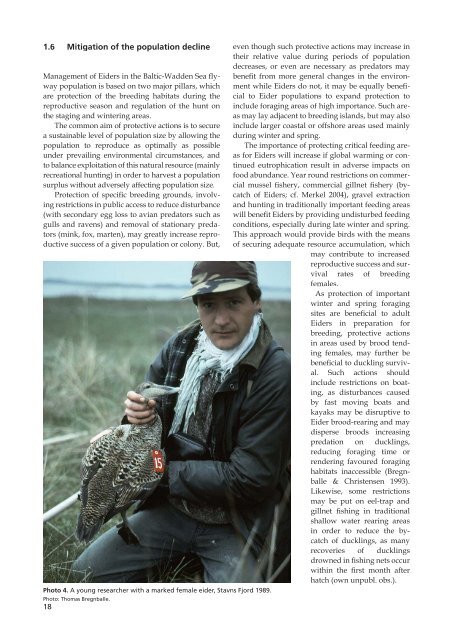Factors affecting population size of Baltic Common Eiders Somateria ...
Factors affecting population size of Baltic Common Eiders Somateria ...
Factors affecting population size of Baltic Common Eiders Somateria ...
Create successful ePaper yourself
Turn your PDF publications into a flip-book with our unique Google optimized e-Paper software.
1.6 Mitigation <strong>of</strong> the <strong>population</strong> decline<br />
Management <strong>of</strong> <strong>Eiders</strong> in the <strong>Baltic</strong>-Wadden Sea flyway<br />
<strong>population</strong> is based on two major pillars, which<br />
are protection <strong>of</strong> the breeding habitats during the<br />
reproductive season and regulation <strong>of</strong> the hunt on<br />
the staging and wintering areas.<br />
The common aim <strong>of</strong> protective actions is to secure<br />
a sustainable level <strong>of</strong> <strong>population</strong> <strong>size</strong> by allowing the<br />
<strong>population</strong> to reproduce as optimally as possible<br />
under prevailing environmental circumstances, and<br />
to balance exploitation <strong>of</strong> this natural resource (mainly<br />
recreational hunting) in order to harvest a <strong>population</strong><br />
surplus without adversely <strong>affecting</strong> <strong>population</strong> <strong>size</strong>.<br />
Protection <strong>of</strong> specific breeding grounds, involving<br />
restrictions in public access to reduce disturbance<br />
(with secondary egg loss to avian predators such as<br />
gulls and ravens) and removal <strong>of</strong> stationary predators<br />
(mink, fox, marten), may greatly increase reproductive<br />
success <strong>of</strong> a given <strong>population</strong> or colony. But,<br />
Photo 4. A young researcher with a marked female eider, Stavns Fjord 1989.<br />
Photo: Thomas Bregnballe.<br />
18<br />
even though such protective actions may increase in<br />
their relative value during periods <strong>of</strong> <strong>population</strong><br />
decreases, or even are necessary as predators may<br />
benefit from more general changes in the environment<br />
while <strong>Eiders</strong> do not, it may be equally beneficial<br />
to Eider <strong>population</strong>s to expand protection to<br />
include foraging areas <strong>of</strong> high importance. Such areas<br />
may lay adjacent to breeding islands, but may also<br />
include larger coastal or <strong>of</strong>fshore areas used mainly<br />
during winter and spring.<br />
The importance <strong>of</strong> protecting critical feeding areas<br />
for <strong>Eiders</strong> will increase if global warming or continued<br />
eutrophication result in adverse impacts on<br />
food abundance. Year round restrictions on commercial<br />
mussel fishery, commercial gillnet fishery (bycatch<br />
<strong>of</strong> <strong>Eiders</strong>; cf. Merkel 2004), gravel extraction<br />
and hunting in traditionally important feeding areas<br />
will benefit <strong>Eiders</strong> by providing undisturbed feeding<br />
conditions, especially during late winter and spring.<br />
This approach would provide birds with the means<br />
<strong>of</strong> securing adequate resource accumulation, which<br />
may contribute to increased<br />
reproductive success and survival<br />
rates <strong>of</strong> breeding<br />
females.<br />
As protection <strong>of</strong> important<br />
winter and spring foraging<br />
sites are beneficial to adult<br />
<strong>Eiders</strong> in preparation for<br />
breeding, protective actions<br />
in areas used by brood tending<br />
females, may further be<br />
beneficial to duckling survival.<br />
Such actions should<br />
include restrictions on boating,<br />
as disturbances caused<br />
by fast moving boats and<br />
kayaks may be disruptive to<br />
Eider brood-rearing and may<br />
disperse broods increasing<br />
predation on ducklings,<br />
reducing foraging time or<br />
rendering favoured foraging<br />
habitats inaccessible (Bregnballe<br />
& Christensen 1993).<br />
Likewise, some restrictions<br />
may be put on eel-trap and<br />
gillnet fishing in traditional<br />
shallow water rearing areas<br />
in order to reduce the bycatch<br />
<strong>of</strong> ducklings, as many<br />
recoveries <strong>of</strong> ducklings<br />
drowned in fishing nets occur<br />
within the first month after<br />
hatch (own unpubl. obs.).

















